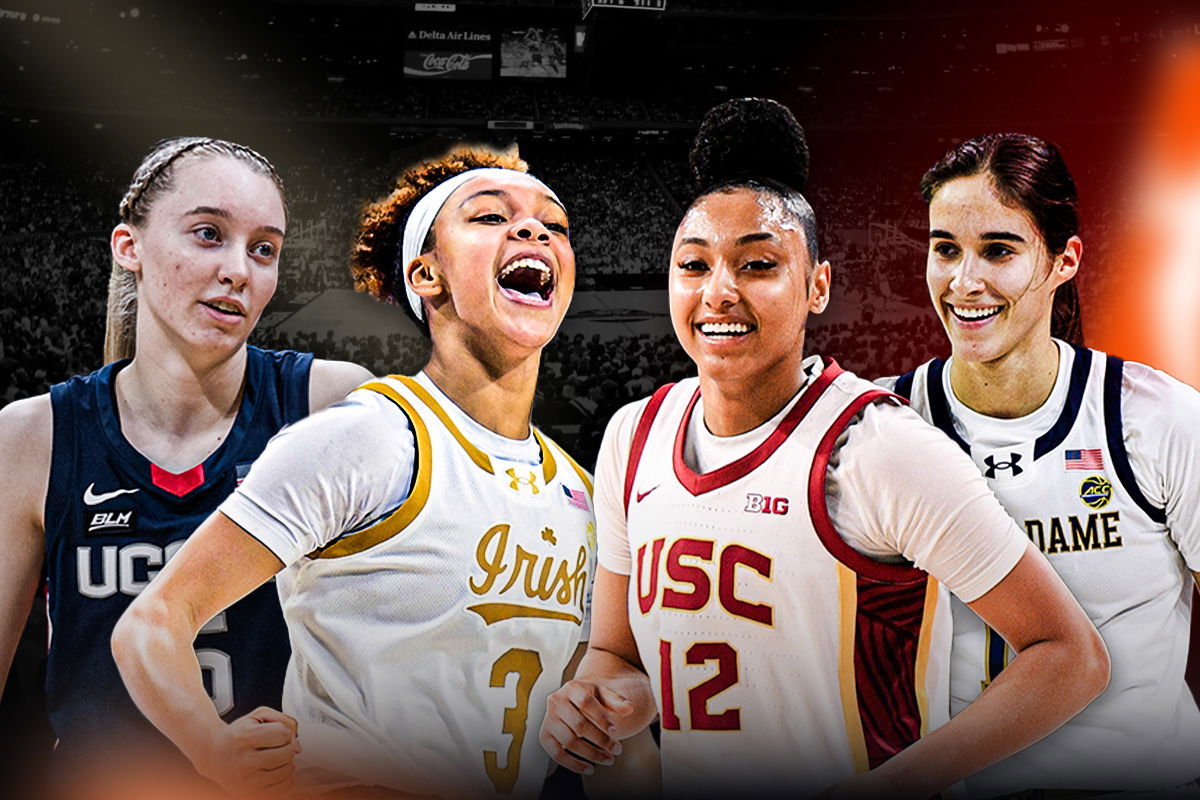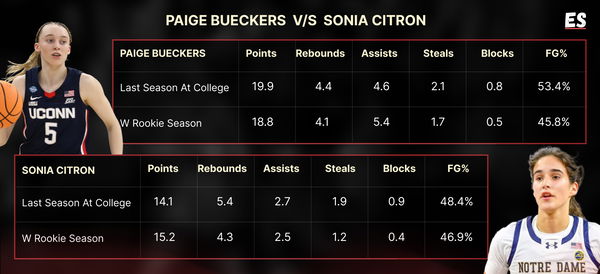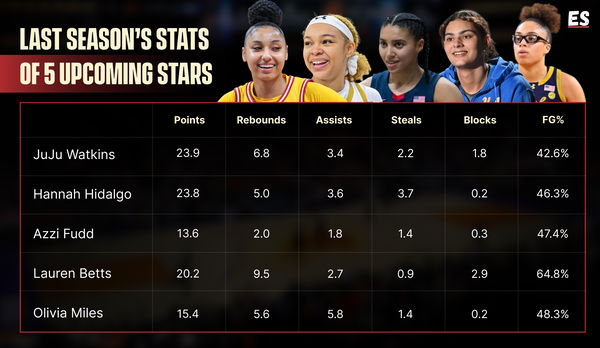
Imago
Credits: Imago

Imago
Credits: Imago
“The demand for women’s basketball has never been higher, and we are thrilled to welcome Cleveland, Detroit, and Philadelphia to the WNBA family.” With those words, Cathy Engelbert set the stage for what might be the most ambitious move in league history. 18 teams by 2030! But something just felt off at the time this announcement made the headlines.
Watch What’s Trending Now!
Last year, the goal was 16 teams by 2028. But now, with negotiations between reputed players and the league hitting an eerily rough patch over the CBA, the timing of this decision feels… complicated. A barrage of WNBA stars have criticized the Cathy Engelbert-led league over its revenue-sharing structure, which is staggeringly low at 9.3% when compared to the NBA’s 49-51% slice to its players.
Is the W really ready to expand this fast? Or is this a gamble?
ADVERTISEMENT
Deemed as a “transformational investment in the future of women’s sports” by Engelbert herself, the WNBA has reportedly agreed to collect $925 million in expansion fees by 2030. This ground-breaking move was finalized about 12 months after securing a $2.2 billion TV deal for the next 11 years. It guaranteed $200 million a year, representing a 6x gain when compared to the prior ESPN deal.
But beyond the money, the real reason to be excited about the WNBA and its future is the talent hub. Yes, Caitlin Clark plays a big role in this discussion, but there’s so much more to it. Two such youngsters are already lighting up the league, and several waves of new players are waiting for their opportunity. That’s what makes this expansion feel less like a gamble and more like perfect timing.
ADVERTISEMENT
Paige Bueckers and Sonia Citron are proving there’s more talent beyond Caitlin Clark
When Caitlin Clark stepped onto a WNBA court after breaking Pete Maravich’s all-time NCAA scoring record, the hype surrounding her name hit an all-time high! The league’s popularity skyrocketed. More than 54 million viewers tuned in to watch the regular season across ABC, CBS, ESPN, ESPN2, ION, and NBA TV. In-arena attendance also reached its peak in 22 years, crossing 2.4 million fans, a massive 48% jump from previous years. Sellout games became the norm as well, with 154 games sold out, compared to just 45 the year before. A 242% increase.
And we’ve not even touched on what Caitlin Clark did on the court in 2024. Hype only lasts if you back it up with performances, and she did exactly that. Clark won Rookie of the Year, earning 66 of 67 votes, and led the Indiana Fever back to the playoffs for the first time since 2016. Along the way, she shattered the WNBA single-season assists record and set the rookie single-season scoring record. It was truly a season to remember.
ADVERTISEMENT
If you were in doubt about how the WNBA was ever going to get a player as impactful on the court as Clark, well, surprisingly enough, the league continues to develop more and more superstars. This year’s Rookie of the Year battle between Paige Bueckers and Sonia Citron has already given us a glimpse of how well-stocked the WNBA is when it comes to emerging talent.
Top Stories
NFL Makes Final Punishment Decision on Shedeur Sanders Incident in Week 17

Chiefs Coach Abruptly Leaves Andy Reid’s Staff Amid Titans’ Rumored Interest in Matt Nagy

“I’d Be Dead”: NASCAR Legend Credits Kevin Harvick for Saving His Life

Jerry Jones Finally Acknowledges the Dak Prescott Gamble Hasn’t Paid Off; Confirms Painful Changes Ahead for Cowboys

Historic NASCAR Track to Change Its Iconic Name as City Council Moves to Auction It Up

Two-Time Venezuelan UFC Champion Clears Stance on Trump’s Takeover and Maduro’s Capture

The No. 1 pick of the 2025 draft, Paige Bueckers, is already playing like she’s been here for years. She’s 4th in scoring among guards, 5th in assists, and tied for 1st in steals. But that’s not all. She’s also shooting an impressive 45.8% from the field while keeping a neat 2.57 assist-to-turnover ratio. She is also the fastest rookie in WNBA history to reach 500 points & 100 assists. Those are not just good rookie numbers–those are All-WNBA kind of numbers.
ADVERTISEMENT

Sonia Citron is also having a phenomenal season of her own. She’s averaging 15.2 points a night, grabbing 4.3 rebounds and dishing out 2.5 assists. Moreover, since Brittney Sykes was traded, Citron has bumped her average to 19.4 points per game, scoring 136 points in her last 7 games, quickly establishing herself as a prime contender for the Rookie of the Year award.
ADVERTISEMENT
Despite Caitlin Clark managing to suit up just 13 times this season, interest remains in the league thanks to this intense ROTY battle, which does have slight shades of Bron and Melo’s rookie race. And while it doesn’t look like the hype will end anytime soon, this excitement isn’t just limited to these three names.
College stars waiting to light up the WNBA…
Ensemble founder Ian Schafer said in an exclusive interview with EssentiallySports’ Chloe V. Mitchell, “You saw with Azzi Fudd, the next generation of talent is coming. Coming fast.”
ADVERTISEMENT
The NIL era has completely changed college sports. Athletes now get to be more than just players—they’re building their own brands through sponsorships, social media, and even live activations at games. For women’s basketball stars, it’s turned out to be a game-changer! Social media has become their megaphone, turning highlights into viral moments and giving them a loyal fanbase long before they become pros.
The passion for college hoops is undeniable. March Madness still captures the nation like nothing else, something the WNBA hasn’t been able to match yet. Just look at the numbers: the 2025 DI women’s championship between UConn and South Carolina drew an average of 8.5 million viewers on ABC, peaking near 10 million. And who can forget the 2024 finals? For the first time ever, the women’s final drew more viewers than the men’s – 18.9 million to 14.8. So whenever a star like Clark or Bueckers makes a move, the eyes naturally follow to the WNBA, and the next generation of talent has the power and ability to do the same.
ADVERTISEMENT

JuJu Watkins
ADVERTISEMENT
If there’s one player who could actually challenge Caitlin Clark’s all-time NCAA scoring record, it’s the standout guard from Los Angeles playing for the USC Trojans. She made history by passing Clark’s mark for the most points scored in a player’s first two college seasons. Clark had 1,662 points as a freshman and sophomore, but JuJu finished the season with 1,709 points–already cementing herself as one of the top scorers in women’s college basketball history.
Unfortunately, her season ended early in the Round of 32 against Mississippi State after a torn ACL. But she still walked away with the National Player of the Year award, outshining a talented field that included this year’s No. 1 pick of the WNBA draft. On top of that, her massive 1.5 million-strong following on Instagram and TikTok means she is all set to bring in major viewership once she eventually makes the jump to the pros.
Hannah Hidalgo
Another standout this season was Notre Dame guard Hannah Hidalgo. She took home both the 2025 ACC Player of the Year and Defensive Player of the Year awards and was a serious contender for National Player of the Year. Hidalgo smashed several Notre Dame records, including single-season scoring average (23.8 points per game), single-season steals (160), and steals per game (4.6). And if that wasn’t enough, she also set the program record for reaching 1,000 career points in just 44 games.
On3 ranks her among the top 50 highest-paid women’s basketball players, a list led by Flau’jae Johnson–another star who’s sure to boost the WNBA’s popularity once she arrives. Hidalgo is represented by the powerhouse agency CAA, and her NIL deals include big names like Red Bull, VKTRY, New Era, Topps, and Aloft South Bend. These partnerships have helped her build a strong personal brand that’s only set to grow over the next couple of years, and when she eventually turns pro, the WNBA will definitely benefit from the extra attention she brings.
Azzi Fudd
Azzi Fudd might already be the ‘most talked-about name’ in the WNBA community after Paige called her her girlfriend—but she’s so much more than that. The UConn guard was this season’s Final Four Most Outstanding Player, and without her stellar performances, winning the championship might have been just a distant dream for the Huskies.
Off the court, Azzi is just as impressive. She’s now hosting Fudd Around And Find Out on iHeartRadio, building partnerships with brands like Bose, TurboTax, Madison Reed, and Paula’s Choice, and has over 600k followers on Instagram. On top of that, she recently signed a major NIL deal with Unrivaled, further cementing her influence and reach. She’s already being talked about as a likely lottery pick for next year’s draft. Whoever lands her won’t just be getting an incredible player; they’ll be adding a potential face of their franchise.
Lauren Betts
If there was anyone besides JuJu who truly deserved the National Player of the Year, it was the UCLA center. She was key in guiding the Bruins to their first-ever number 1 overall seed on Selection Sunday. She carried UCLA to its first Final Four in program history, delivering clutch performances all season. It was a record-breaking campaign, with her averaging over 20 points and 9.5 rebounds on 64.8% shooting. In an era where bigs like A’ja Wilson, Angel Reese, Kamilla Cardoso, and Aliyah Boston continue to dominate the paint, it wouldn’t be surprising if Lauren Betts stepped into the WNBA and made a similar impact.
Olivia Miles
In four seasons at Notre Dame, Olivia Miles has grown into one of the country’s top guards. Last season, she averaged a career-high 15.4 points per game and dramatically improved her 3-point shooting, jumping from 22.8% in 2022-23 to 40.6%. Miles has been named to an AP All-American team twice and earned All-ACC First-team honors three times in 2022, 2023, and 2025.
Olivia was supposed to be one of the lottery picks for this year’s draft but chose to exercise her eligibility year after missing the 2023-24 year with injury. She was widely projected to be the No. 2 overall pick in the draft behind UConn’s Paige Bueckers! Regardless, Miles will definitely be one of the lottery picks in next year’s draft and has the potential to become the league’s next Alyssa Thomas.
These are just a few cherry-picked names ready to make their mark at the pro level.
Players like Flau’jae Johnson, Ta’Niya Latson, Kiki Rice, and Gianna Kneepkens have already shown they can shine in high-pressure moments. Then there are youngsters like Mikayla Blakes, who dropped multiple 50-point games as a freshman, and Tennessee’s Talaysia Cooper–talents definitely worth watching in the years to come. If they’re all able to replicate their college numbers in the W, expect each one of them to retire from the league as legends.
Why the WNBA expansion strategy doesn’t seem to be a problem
There’s been plenty of debate around the WNBA’s four-year age rule, which keeps most players from turning pro immediately—unlike the NBA—and questions from players like Satou Sabally on whether adding roster spots instead of expanding would have been smarter. But now that the final decision is made, it’s worth understanding why it actually works.
With so many talented players on the horizon, having a superstar lead a specific market is a smart strategy for the league’s growth and visibility.
As Economics professor Victor Matheson noted in a report covered by Dow Jones reporter Weston Blasi, “It would be a problem if the WNBA was expanding into Lexington or Birmingham or Little Rock. But that’s not where they are going. They are going to Cleveland, Detroit, Philadelphia – big NBA cities that have shown a taste for basketball.”
“The bigger footprint nationwide the league has, the more they force folks like ESPN to cover them. It’s a lot easier to ignore a league with only 10 major cities as opposed to 20 or 30. That’s something that [Major League Soccer] learned – is that in order to get attention from everyone … you have to be basically in every market.”
Having talented youngsters join the newer teams could turn them into icons, attracting more fans and growing the league’s reach. And that is probably what the goal of the WNBA is– rather than just expanding rosters and stacking superstars on a few teams, they want to distribute talent equally across all markets.
What’s your take on this move? Drop your thoughts in the comments below!
ADVERTISEMENT
ADVERTISEMENT
ADVERTISEMENT

